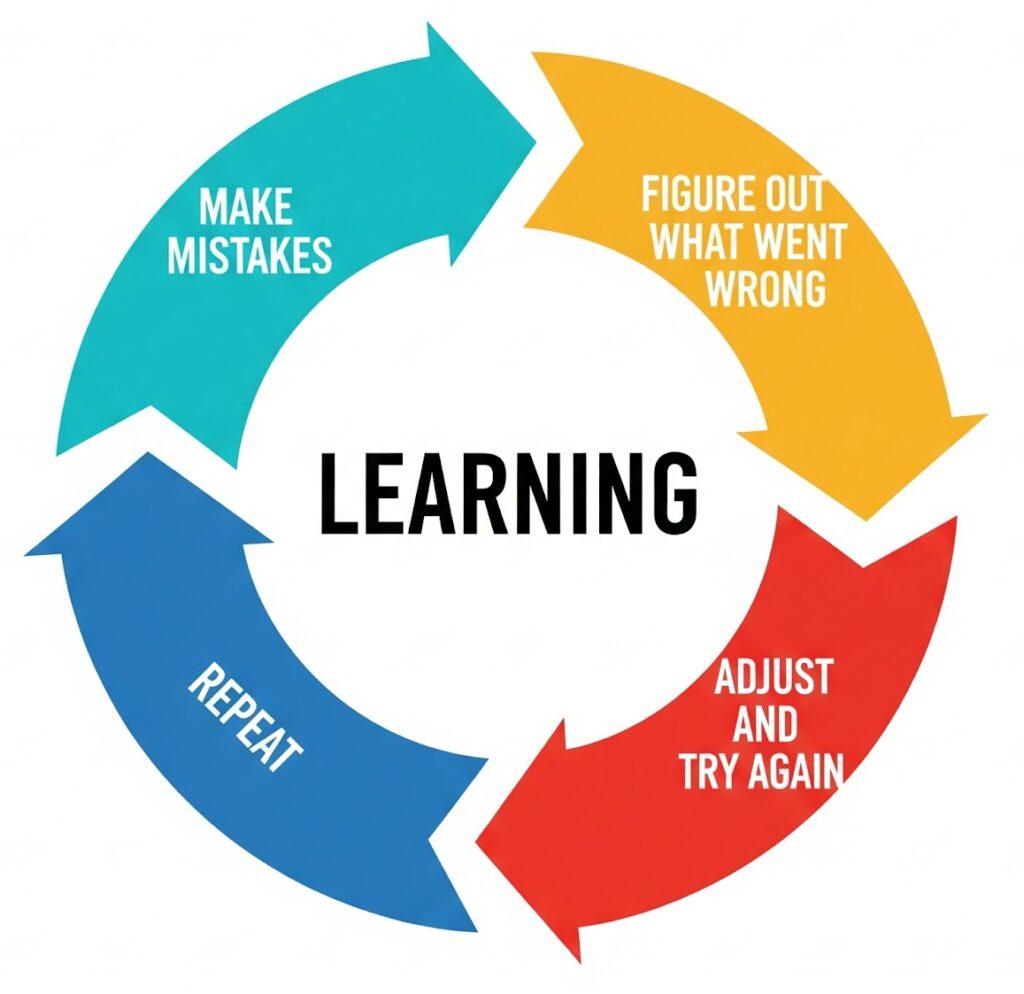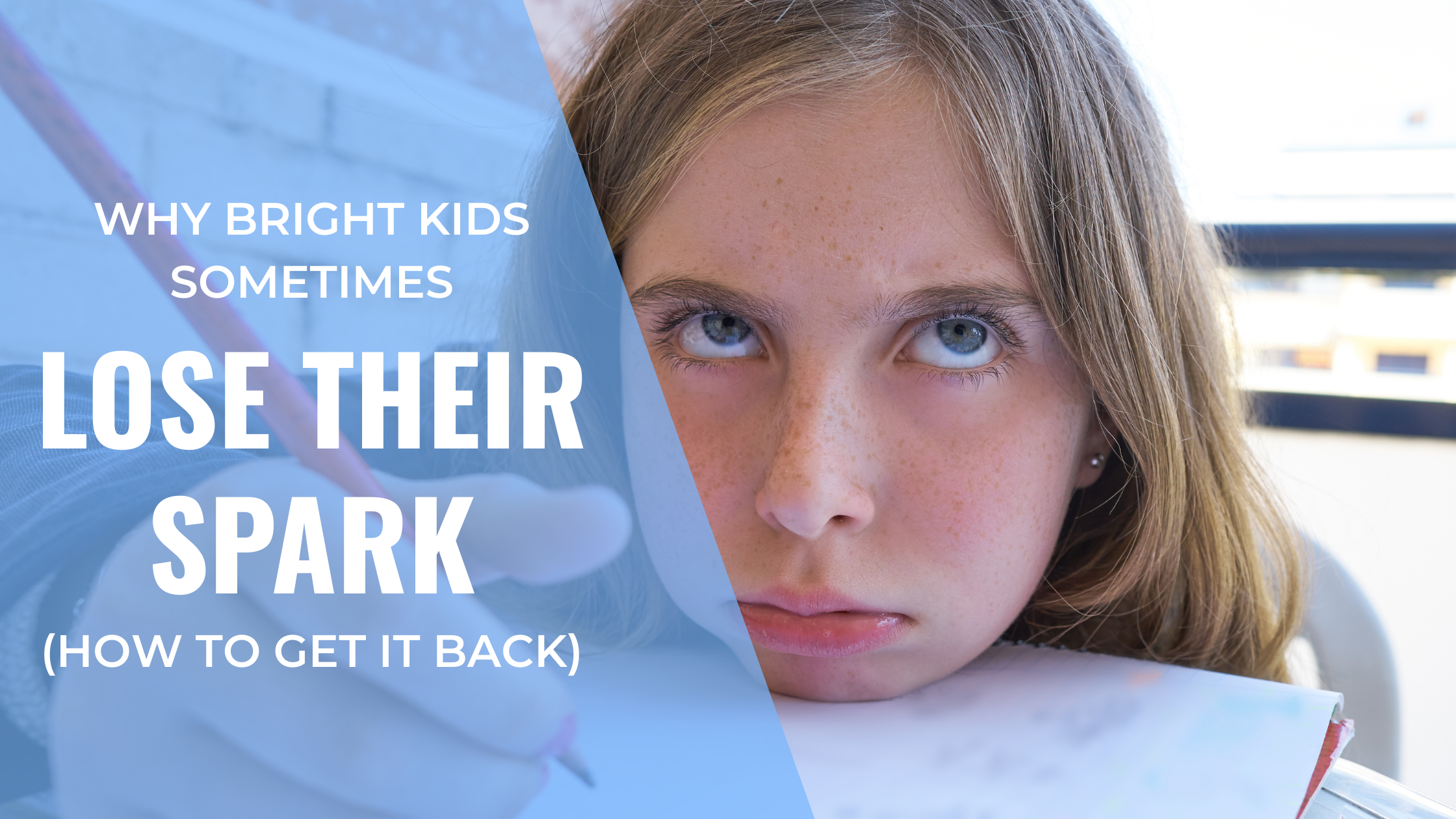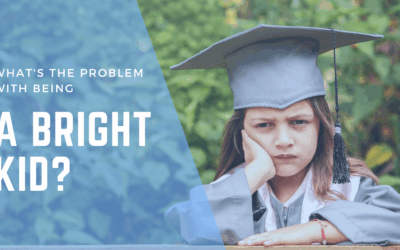Kat sailed through elementary and middle school. Her parents never had to hover over her homework. She aced every test, spoke up in class, and finished assignments in minutes.
Then came ninth grade. Her grades slipped, she stopped raising her hand — she seemed… adrift. A drop in grades. Hesitation in class. A quiet retreat from challenges she once embraced. This wasn’t just a bad week; Kat had lost her confidence.
It’s a story we hear often from bright kids who’ve always had it easy. How did it happen? To parents and teachers, it can feel like it happened overnight. It didn’t.
How can we, as parents, teachers, and counselors, help them get that spark back?
Could “too easy” actually be a problem?
It sounds counterintuitive: how can doing well in school be a problem? For some students, early success is a double-edged sword.
They’re sailing through, but are they learning how to struggle?
Some kids start school with a tailwind so strong, it feels like they’ll never lose it. They pick things up fast. They breeze through assignments. Teachers call them “gifted.” Kat flew through elementary and middle school with top marks and no sweat. Everyone’s thrilled.
But here’s the catch: when nothing feels hard, students lose the opportunity to learn what to do when something is hard. As Kat sailed through, she got away with never having to learn how to learn.
She never developed the voice in her head that alerted her when she didn’t understand. She never built study habits or figured out how to push through when work got tough. She never worked the muscle. Up until 9th grade, she never needed to—nothing truly challenged her. It’s like teaching a runner only to sprint—fast and impressive, but fragile when the race turns uphill.
Hitting “the wall”
The wall comes in different forms:
The first AP class. The SAT. A math problem that resists every trick they know.
When it happens, most bright students respond the only way they know how: they try to brain it harder. They read the page again. And again. They stare at the problem until the numbers blur. They push their minds into overdrive, hoping sheer willpower will win. Sometimes it works. But eventually, it doesn’t.
Kat’s wall came when she first took AP Calculus AB. The workload increased sharply from what she was used to, and for the first time, she struggled. Her effortless excellence felt like a sham. Her identity as a “gifted student” began to falter. Kat was left wondering if her school had failed her, and her doubt endangered her confidence.
The school system isn’t helping
Middle-school curricula often leave bright students yawning through class. They aren’t pushed or challenged.
Imagine a teacher with twenty students: fifteen struggle to keep up, and five ace every assignment without trying. Most of the teacher’s time goes to the majority in need, and you can’t really blame them. But it means that, by design, the high achievers skate by, under-engaged and underserved. They never lift, or even feel, the weight of a real challenge.
Researchers (Bain & Moon, 2020) have found that boredom, not laziness or attitude, is one of the biggest culprits behind underachievement in gifted students. When the material is too easy for too long, even the most engaged learners check out, signaling unmet cognitive needs.
In a system designed to level everyone out, those bright sparks risk flickering out.
How do we spot the warning signs before it’s too late?
Catching a confidence dip early is key, but tricky. Bright students hide their struggles well. They keep up appearances even as they begin to falter.
Early clues to look for
- Everything feels “too easy.” If Kat insists there’s no next level, she may be avoiding challenges, or might be underserved in the classroom.
- Fear of trying new things. Stepping outside comfort zones triggers Kat’s anxiety.
- Obsession with perfect grades. Kat panics over anything less than 100%, signalling self-doubt.
- Downplaying achievements. Even when she gets an “A”, she can’t help but focus on tiny mistakes.
- Withdrawal or loss of interest. Hobbies and passions fall by the wayside when there’s always more studying to be done. (Or they begin to take up even more time, pushing schoolwork to the edges, as for the first time schoolwork becomes genuinely uncomfortable.)
- Perfectionism to a fault. Instead of challenging herself with new problems, she constantly re-does old work in hopes of reclaiming control.
Each of these signs goes against true learning, which demands challenge and occasional failure to grow.
But what if she doesn’t know it’s happening?
Confidence rarely crashes overnight. A thousand tiny doubts erode it over time. Because Kat’s been praised for her innate gifts, her brain learned to chase test scores at the expense of real growth. That wiring makes her the last to notice when her confidence slips. Then, when she is approached by a problem her natural smarts can’t tackle, she assumes: “a-hah, this must be my limit.”
Parents and teachers must watch closely and build a safe space for honest conversation. Assuming that “A’s mean everything is fine” can leave serious struggles unaddressed, especially in the current environment of rampant grade inflation, spotting these early warning signs ensures Kat’s spark stays bright well beyond her schooling years.
What “failing” does to them
For a student who’s always been told “you’re smart,” failure doesn’t just sting—it shakes their identity. Kids like Kat, praised as “the smart one,” take a bad grade as a personal catastrophe. Sometimes these students have relied so heavily on their natural smarts, and the identity that gives them, that they don’t feel as confident about other sources of positive identity. Failing threatens who they think they are.
If being smart is their whole story, what happens when the story changes?
How do fear, failure, and a shaky sense of self play into this?
- Fear of failure takes over. For some, the answer is quiet withdrawal. They stop raising their hand. They pick easier classes. (Ideally, classes that seem challenging to their parents, but aren’t actually challenging for them.) Kat starts avoiding anything that might expose her to the risk of failure. Because beginners are bad by design, her fear prevents her from trying anything new.
- Procrastination and avoidance. She begins to delay assignments rather than face possible mistakes. Things pile up and overwhelm her.
- Paralyzing pressure. When self-worth is tied to success, one setback can feel like the end.
- An identity crisis emerges. Imagine Kat’s world: always celebrating A’s, having dinner outings after finals, and friends relying on her help. Then AP Calculus arrives, and she struggles. Her grades drop for the first time. She asks herself:
- “How do I explain this to myself and others?”
- “How do I rebuild my confidence?”
- “Can I ever feel ‘smart’ again?”
(But, of course, these questions mostly manifest as unconscious anxieties rather than rational questions, which means none of her support system engages to help her effectively.)
Can we all just agree that failure is part of the process?
“Natural smarts” aren’t how most people become successful. We need a mindset shift. Failure isn’t a catastrophe; it’s essential for learning. Progress happens when you:
- Make mistakes
- Figure out what went wrong, without judgment
- Adjust and try again

That cycle builds resilience and thoughtful problem-solving.
This shift requires effort from everyone—parents, teachers, mentors—and may even mean seeking specialized help or considering alternative schooling to ensure Kat learns that falling short is just part of getting stronger.
What is the process, then? Here’s the good news: confidence isn’t a finite resource. It can be rebuilt, and it can come back stronger than before—if students learn the skills that “braining it harder” can’t give them.
Skills like:
- Knowing how to spot a problem early
- Choosing from multiple ways to approach it
- Managing time and attention under pressure
- Keeping calm while the clock is ticking
When these habits take root, Kat can learn to slow down, analyze, and choose strategies, instead of defaulting to panic or brute force. She can learn when to move on and when to double down. She doesn’t just survive the next hard thing—she’s ready to take it on.
How do we build confidence that actually lasts?
Building real, lasting confidence is a marathon, not a sprint. It goes way beyond just getting good grades.
The 80% rule
When we tell parents to encourage their kids to aim for about 80% success, not 100%, they look at us funny. Aren’t we the ones who are supposed to help their kid excel? It might seem odd for a high-achieving student, but this target strikes the right balance between challenge and growth.
The point is to normalize failure by building it into everyone’s expectations from the start.
It says:
“The occasional failure is good for you. It shows you where your current limits are, and gives you the feedback you need to push those limits outward. Failing at something difficult from time to time is far better for you than trying to maintain a perfect record.”
Here’s what I mean:
- Growth over perfection: Aiming for 100% means optimizing for flawlessness. But youth is a time for exploration, not perfection. Trying hard things, even if they sometimes fail, is how students discover what they’re capable of. And the overemphasis on 100% is exactly what gets kids into the perfectionist trap. If a student gets an A+ on a test, that A+ is meaningless: they’ve maxed out the test, it’s too easy for them, and the A+ doesn’t signal their level of understanding, nor does it show them the path to continued improvement. So if we’re all so focused on the A+, we’re getting caught up in a metric that has lost its meaning, and assigning value to students who get that grade. Honestly, it’s bonkers.
- Challenge at the edge: 80% success means Kat is operating at the edge of her ability, where real growth happens. It gives her room to grow. She’s encouraged by the potential of 80%, keeping her mind open and flexible. A lower threshold is overwhelming – too much distance to cover. A higher threshold is too easy – if she’s trained to think that 100% signals success, she’ll feel like she knows everything when she maxes out her high school classes at the age of 17. (“A teenager who knows everything?” I hear you cry. Oh, yes, it happens. 😉 )
- Why this matters for gifted students: Most students get sufficient growth just by moving through the school system as it is. But students like Kat don’t. For them, the system feels like a gym where the only available weights are 3-pound dumbbells. They show up, go through the motions, and stay stagnant. Worse: in school, unlike in a real gym, finding heavier weights is surprisingly difficult. That’s why a deliberate effort to engineer a challenge is essential.
| This pattern often catches up with students in college or advanced courses, where expectations shift dramatically. One study found that gifted students frequently struggle at that point because their earlier academic environments didn’t require them to build strong time management, study skills, or deep content mastery. (Reis & McCoach, 2015) |
- Tolerance for failure as a means to an end: If failure feels unacceptable, Kat will avoid risk. But without risk, there’s no challenge. And without challenge, there’s no growth. Tolerating failure makes meaningful work possible.
Lift too light, and you won’t grow. Too heavy, and you’ll get hurt. The right load builds strength. Here, that sweet spot lives at about 80% success.
The growth mindset
A growth mindset means believing intelligence and abilities can improve through effort, perseverance, and learning from mistakes. When Kat believes she can get smarter, she’s more likely to tackle tough challenges, persist when things get hard, and reach her full potential.
Richness and growth emerge from struggle. Developing this mindset early helps her become a lifelong learner, unafraid of setbacks and confident in her ability to grow.
So, how do we actually get that confidence back?
Let’s back up. We’ve talked about where the path leads, but how do we set Kat on that path? Restoring Kat’s confidence isn’t a quick fix. It takes patience, understanding, and digging into the root of the cause.
We should all be working together on this
Rebuilding confidence is a team effort. Parents, teachers, and coaches need to collaborate. Yet many schools, even “high-value” ones, lack the resources or structure to fully support bright students. That means that Kat slips through the cracks.
Options to consider:
- Homeschooling or microschool programs that tailor challenges to Kat’s needs
- Outside coaching that complements classroom learning
- Finding a school committed to individualized support and healthy academic challenges, e.g., through robust differentiation
Open communication is vital. Keeping everyone aligned on Kat’s goals and progress ensures she has the consistent support she needs to shine again.
What kind of help actually makes a difference?
Specialized support (tutoring or educational coaching) can be a game-changer. The right coach offers more than subject help; they guide mindset, build study habits, and address emotional hurdles. They can:
- Provide personalized strategies for Kat’s learning style
- Introduce a growth mindset that embraces challenge and failure
- Rebuild her self-confidence by celebrating small victories
At Wes Carroll Tutoring & Coaching, we specialize in helping bright students like Kat rediscover their love of learning and achieve lasting success. If you spot these warning signs, let’s talk about how we can help.
The bottom line
Losing confidence is complex. And it can leave scars, especially for bright kids like Kat. Early success in an unchallenging system can leave them unprepared for real obstacles. When they face a bump in the road, a shaky sense of identity tied to being “smart” can trigger a major confidence crash.
But it’s not hopeless. Far from it! By spotting warning signs early, reframing failure as a tool for growth, and providing coordinated support, we can all help Kat—and students like her—rebuild lasting confidence. Long-term strategies like the 80% rule and emphasis on practical components of a growth mindset give them the resilience and self–belief to thrive in school and life.
These students have immense potential. With the right support and environment, Kat can rediscover her spark and achieve amazing things, built on genuine confidence and a love of learning.




0 Comments